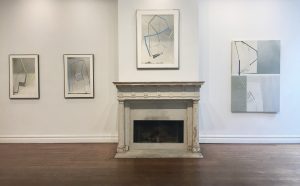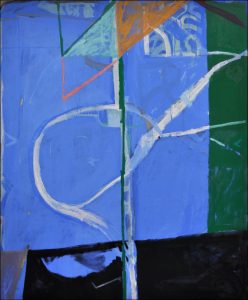 The collision and/or communion between repetition and randomness in the visual world is a perpetual source of interest for me. Just as what is regarded as “standard” I think of as being too formally familiar. Dichotomy and conflict create inventive dialectic. There is in this world a ubiquitous visual paradox which is a constant source of creative potential. As Oscar Wilde accurately put it: “The true mystery of the world is the VISIBLE not the INVISIBLE”. I wish to go there for a language.
The collision and/or communion between repetition and randomness in the visual world is a perpetual source of interest for me. Just as what is regarded as “standard” I think of as being too formally familiar. Dichotomy and conflict create inventive dialectic. There is in this world a ubiquitous visual paradox which is a constant source of creative potential. As Oscar Wilde accurately put it: “The true mystery of the world is the VISIBLE not the INVISIBLE”. I wish to go there for a language.
-Gordon Moore
Anita Rogers Gallery is thrilled to present an exhibition of new works on canvas and photo emulsion paper by the American painter, Gordon Moore. The exhibition will be on view February 15 – April 1, 2017 at 77 Mercer Street #2N, New York, NY.
In this exhibition Moore’s current work continues an interest in the dialogue he has developed over the past decade between the spontaneous flow of painterly liquids and the specific structural framework of his abstract configurations. The esoteric nature of abstraction offers an unlimited potential for invention. Using photo-emulsion paper as a ground for drawing, Moore embraces and encourages the imperfections inherent in the interaction between developer and emulsion. This in turn nurtures Moore’s large scale works on canvas which explore a similar approach to depth, dimension, balance and asymmetry. Moore’s pieces are exercises in asymmetrical equilibrium that challenge the viewers’ natural perceptions. The collection of works on view here are thoughtful meditations on connections and alignments – on the interaction between flatness and depth, deliberation and spontaneity, the real world and the painted world and finally between abstraction and figuration.
 Born in Cherokee, IA, Moore received his undergraduate degree from the University of Washington, Seattle in 1970 and then went on to receive his MFA from Yale University in 1972. He has received numerous awards and grants including the National Endowment for the Arts-Visual Artists Fellowship, the Louis Comfort Tiffany Foundation Award in Painting, the Adolph and Ester Gottlieb Foundation Award in Painting, the Academy Award in Art from the American Academy of Arts and Letters, Pollock Krasner Foundation Grant and the New York Foundation for the Arts Fellowship. Moore’s work can be seen in the collections of the Museum of Fine Arts (Boston, MA), Yale University Art Gallery (CT), Baltimore Museum of Art (MD), General Electric Corporation (OH), the Krannert Art Museum (IL) and Kinkead Pavilion (IL).
Born in Cherokee, IA, Moore received his undergraduate degree from the University of Washington, Seattle in 1970 and then went on to receive his MFA from Yale University in 1972. He has received numerous awards and grants including the National Endowment for the Arts-Visual Artists Fellowship, the Louis Comfort Tiffany Foundation Award in Painting, the Adolph and Ester Gottlieb Foundation Award in Painting, the Academy Award in Art from the American Academy of Arts and Letters, Pollock Krasner Foundation Grant and the New York Foundation for the Arts Fellowship. Moore’s work can be seen in the collections of the Museum of Fine Arts (Boston, MA), Yale University Art Gallery (CT), Baltimore Museum of Art (MD), General Electric Corporation (OH), the Krannert Art Museum (IL) and Kinkead Pavilion (IL).
 The collision and/or communion between repetition and randomness in the visual world is a perpetual source of interest for me. Just as what is regarded as “standard” I think of as being too formally familiar. Dichotomy and conflict create inventive dialectic. There is in this world a ubiquitous visual paradox which is a constant source of creative potential. As Oscar Wilde accurately put it: “The true mystery of the world is the VISIBLE not the INVISIBLE”. I wish to go there for a language. – Gordon Moore
The collision and/or communion between repetition and randomness in the visual world is a perpetual source of interest for me. Just as what is regarded as “standard” I think of as being too formally familiar. Dichotomy and conflict create inventive dialectic. There is in this world a ubiquitous visual paradox which is a constant source of creative potential. As Oscar Wilde accurately put it: “The true mystery of the world is the VISIBLE not the INVISIBLE”. I wish to go there for a language. – Gordon Moore The collision and/or communion between repetition and randomness in the visual world is a perpetual source of interest for me. Just as what is regarded as “standard” I think of as being too formally familiar. Dichotomy and conflict create inventive dialectic. There is in this world a ubiquitous visual paradox which is a constant source of creative potential. As Oscar Wilde accurately put it: “The true mystery of the world is the VISIBLE not the INVISIBLE”. I wish to go there for a language.
The collision and/or communion between repetition and randomness in the visual world is a perpetual source of interest for me. Just as what is regarded as “standard” I think of as being too formally familiar. Dichotomy and conflict create inventive dialectic. There is in this world a ubiquitous visual paradox which is a constant source of creative potential. As Oscar Wilde accurately put it: “The true mystery of the world is the VISIBLE not the INVISIBLE”. I wish to go there for a language. Born in Cherokee, IA, Moore received his undergraduate degree from the University of Washington, Seattle in 1970 and then went on to receive his MFA from Yale University in 1972. He has received numerous awards and grants including the National Endowment for the Arts-Visual Artists Fellowship, the Louis Comfort Tiffany Foundation Award in Painting, the Adolph and Ester Gottlieb Foundation Award in Painting, the Academy Award in Art from the American Academy of Arts and Letters, Pollock Krasner Foundation Grant and the New York Foundation for the Arts Fellowship. Moore’s work can be seen in the collections of the Museum of Fine Arts (Boston, MA), Yale University Art Gallery (CT), Baltimore Museum of Art (MD), General Electric Corporation (OH), the Krannert Art Museum (IL) and Kinkead Pavilion (IL).
Born in Cherokee, IA, Moore received his undergraduate degree from the University of Washington, Seattle in 1970 and then went on to receive his MFA from Yale University in 1972. He has received numerous awards and grants including the National Endowment for the Arts-Visual Artists Fellowship, the Louis Comfort Tiffany Foundation Award in Painting, the Adolph and Ester Gottlieb Foundation Award in Painting, the Academy Award in Art from the American Academy of Arts and Letters, Pollock Krasner Foundation Grant and the New York Foundation for the Arts Fellowship. Moore’s work can be seen in the collections of the Museum of Fine Arts (Boston, MA), Yale University Art Gallery (CT), Baltimore Museum of Art (MD), General Electric Corporation (OH), the Krannert Art Museum (IL) and Kinkead Pavilion (IL). London based painter Tristan Barlow is in a two person show with Dutch-born photographer Hans Neleman at Anita Rogers in Soho. Both artists explore processes of accumulation and excavation of cultural imagery and sensual physical substance. Barlow employs layers of marks and shapes that gel into luscious intuitive abstractions that convey a dynamic sense of place. Neleman constructs framed assemblages with great attention to the nuances of mystery and meaning latent in his time-worn found materials and images.
London based painter Tristan Barlow is in a two person show with Dutch-born photographer Hans Neleman at Anita Rogers in Soho. Both artists explore processes of accumulation and excavation of cultural imagery and sensual physical substance. Barlow employs layers of marks and shapes that gel into luscious intuitive abstractions that convey a dynamic sense of place. Neleman constructs framed assemblages with great attention to the nuances of mystery and meaning latent in his time-worn found materials and images.